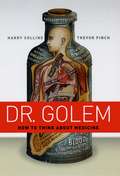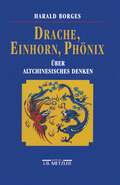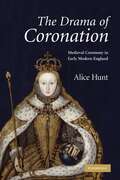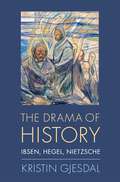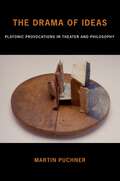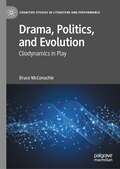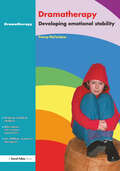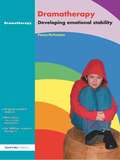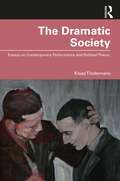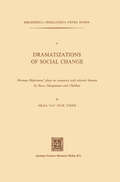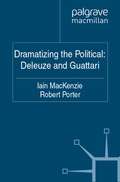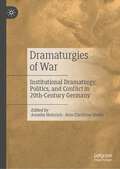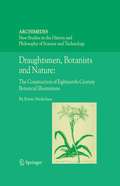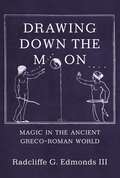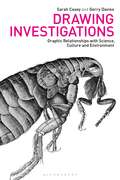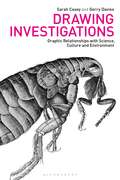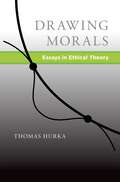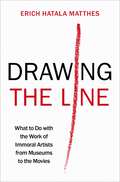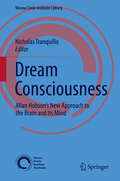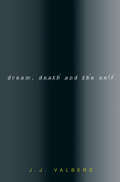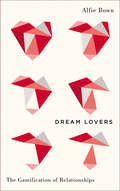- Table View
- List View
Dr. Golem: How to Think about Medicine
by Harry Collins Trevor PinchA creature of Jewish mythology, a golem is an animated being made by man from clay and water who knows neither his own strength nor the extent of his ignorance. Like science and technology, the subjects of Harry Collins and Trevor Pinch's previous volumes, medicine is also a golem, and this Dr. Golem should not be blamed for its mistakes—they are, after all, our mistakes. The problem lies in its well-meaning clumsiness. Dr. Golem explores some of the mysteries and complexities of medicine while untangling the inherent conundrums of scientific research and highlighting its vagaries. Driven by the question of what to do in the face of the fallibility of medicine, Dr. Golem encourages a more inquisitive attitude toward the explanations and accounts offered by medical science. In eight chapters devoted to case studies of modern medicine, Collins and Pinch consider the prevalence of tonsillectomies, the placebo effect and randomized control trials, bogus doctors, CPR, the efficacy of Vitamin C in fighting cancer, chronic fatigue syndrome, AIDS cures, and vaccination. They also examine the tension between the conflicting faces of medicine: medicine as science versus medicine as a source of succor; the interests of an individual versus the interests of a group; and the benefits in the short term versus success rates in the long term. Throughout, Collins and Pinch remind readers that medical science is an economic as well as a social consideration, encapsulated for the authors in the timeless struggle to balance the good health of the many—with vaccinations, for instance—with the good health of a few—those who have adverse reactions to the vaccine. In an age when the deaths of research subjects, the early termination of clinical trials, and the research guidelines for stem cells are front-page news, Dr. Golem is a timely analysis of the limitations of medicine that never loses sight of its strengths.
The Drama Of Coronation: Medieval Ceremony In Early Modern England
by Alice HuntThe coronation was, and perhaps still is, one of the most important ceremonies of a monarch's reign. This book examines the five coronations that took place in England between 1509 and 1559. It considers how the sacred rite and its related ceremonies and pageants responded to monarchical and religious change, and charts how they were interpreted by contemporary observers. Hunt challenges the popular position that has conflated royal ceremony with political propaganda and argues for a deeper understanding of the symbolic complexity of ceremony. At the heart of the study is an investigation into the vexed issues of legitimacy and representation which leads Hunt to identify the emergence of an important and fruitful exchange between ceremony and drama. This exchange will have significant implications for our understanding both of the period's theatre and of the cultural effects of the Protestant Reformation.
The Drama of History: Ibsen, Hegel, Nietzsche
by Kristin GjesdalHenrik Ibsen's plays have long beguiled philosophically-oriented readers. From Nietzsche to Adorno to Cavell, philosophers have drawn inspiration from Ibsen. But what of Ibsen's own philosophical orientation? As part of larger European movements to reinvent drama, Ibsen and fellow playwrights grappled with contemporary philosophy. Philosophy of drama found a central place with figures such as Gotthold Ephraim Lessing and Johann Gottfried Herder, but reached its mature form, in Ibsen's time, in the works of G.W.F. Hegel and Friedrich Nietzsche. Kristin Gjesdal reveals the centrality of philosophy of theater in nineteenth-century philosophy and shows how drama, as an art form, offers insight into human historicity and the conditions of modern life. The Drama of History deepens and actualizes the relationship between philosophy and drama--not by suggesting that either philosophy or drama should have the upper hand, but rather by indicating how a sustained dialogue between them brings out the meaning and intellectual power of each. Her study reveals underappreciated aspects of Hegel's and Nietzsche's works through their reception in European art and investigates the philosophical dimensions of Ibsen's drama. At the heart of this interrelation between philosophy and drama is a shared interest in exploring the existential condition of human life as lived and experienced in history.
The Drama of History: Ibsen, Hegel, Nietzsche
by Kristin GjesdalHenrik Ibsen's plays have long beguiled philosophically-oriented readers. From Nietzsche to Adorno to Cavell, philosophers have drawn inspiration from Ibsen. But what of Ibsen's own philosophical orientation? As part of larger European movements to reinvent drama, Ibsen and fellow playwrights grappled with contemporary philosophy. Philosophy of drama found a central place with figures such as Gotthold Ephraim Lessing and Johann Gottfried Herder, but reached its mature form, in Ibsen's time, in the works of G.W.F. Hegel and Friedrich Nietzsche. Kristin Gjesdal reveals the centrality of philosophy of theater in nineteenth-century philosophy and shows how drama, as an art form, offers insight into human historicity and the conditions of modern life. The Drama of History deepens and actualizes the relationship between philosophy and drama--not by suggesting that either philosophy or drama should have the upper hand, but rather by indicating how a sustained dialogue between them brings out the meaning and intellectual power of each. Her study reveals underappreciated aspects of Hegel's and Nietzsche's works through their reception in European art and investigates the philosophical dimensions of Ibsen's drama. At the heart of this interrelation between philosophy and drama is a shared interest in exploring the existential condition of human life as lived and experienced in history.
The Drama of Ideas: Platonic Provocations in Theater and Philosophy
by Martin PuchnerMost philosophy has rejected the theater, denouncing it as a place of illusion or moral decay; the theater in turn has rejected philosophy, insisting that drama deals in actions, not ideas. Challenging both views, The Drama of Ideas shows that theater and philosophy have been crucially intertwined from the start. Plato is the presiding genius of this alternative history. The Drama of Ideas presents Plato not only as a theorist of drama, but also as a dramatist himself, one who developed a dialogue-based dramaturgy that differs markedly from the standard, Aristotelian view of theater. Puchner discovers scores of dramatic adaptations of Platonic dialogues, the most immediate proof of Plato's hitherto unrecognized influence on theater history. Drawing on these adaptations, Puchner shows that Plato was central to modern drama as well, with figures such as Wilde, Shaw, Pirandello, Brecht, and Stoppard using Plato to create a new drama of ideas. Puchner then considers complementary developments in philosophy, offering a theatrical history of philosophy that includes Kierkegaard, Nietzsche, Burke, Sartre, Camus, and Deleuze. These philosophers proceed with constant reference to theater, using theatrical terms, concepts, and even dramatic techniques in their writings. The Drama of Ideas mobilizes this double history of philosophical theater and theatrical philosophy to subject current habits of thought to critical scrutiny. In dialogue with contemporary thinkers such as Martha Nussbaum, Iris Murdoch, and Alain Badiou, Puchner formulates the contours of a "dramatic Platonism." This new Platonism does not seek to return to an idealist theory of forms, but it does point beyond the reigning philosophies of the body, of materialism and of cultural relativism.
Drama, Politics, and Evolution: Cliodynamics in Play (Cognitive Studies in Literature and Performance)
by Bruce McConachieThis book outlines the evolution of our political nature over two million years and explores many of the rituals, plays, films, and other performances that gave voice and legitimacy to various political regimes in our species’ history. Our genetic and cultural evolution during the Pleistocene Epoch bestowed a wide range of predispositions on our species that continue to shape the politics we support and the performances we enjoy. The book’s case studies range from an initiation ritual in the Mbendjela tribe in the Congo to a 1947 drama by Bertolt Brecht and include a popular puppet play in Tokugawa Japan. A final section examines the gradual disintegration of social cohesion underlying the rise of polarized politics in the USA after 1965, as such films as The Godfather, Independence Day, The Dark Knight Rises, and Joker accelerated the nation’s slide toward authoritarian Trumpism.
Dramatherapy: Raising Children's Self-Esteem and Developing Emotional Stability
by Penny McFarlaneProviding a new and proven way forward for practitioners who want to help children, but who do not have recourse to a qualified therapist, this book covers: tried and tested practical activities to use with children simple explanations of how and why dramatherapy works informative case studies that show activities being used in practice a useful list of further reading, centres for training and qualifications.
Dramatherapy: Raising Children's Self-Esteem and Developing Emotional Stability
by Penny McFarlaneProviding a new and proven way forward for practitioners who want to help children, but who do not have recourse to a qualified therapist, this book covers: tried and tested practical activities to use with children simple explanations of how and why dramatherapy works informative case studies that show activities being used in practice a useful list of further reading, centres for training and qualifications.
The Dramatic Society: Essays on Contemporary Performance and Political Theory
by Klaas TindemansAll societies are, by their very nature, dramatic. They present themselves, especially for those who want to look back in time, as a fascinating and confusing whole of theatrical events and constructions. Sometimes the theatre itself succeeds in capturing that fascination and confusion. This book describes the dramatic society in the form of case studies that link politics, history and culture. The Dramatic Society uses selected plays to examine specific moments in history. Its range of subjects are extremely diverse, including Medea as an icon of terrorism, a choreography based upon Shakespeare’s As You Like It, horror movies about the German unification, a truth commission dealing with "human zoos", and the reconstruction of Ai Weiwei’s troubles with the tax authorities. This collection of insightful essays deals with theatrical performances – including happenings, installations and movies – of the past fifty years, with every chapter attempting to link artistic events with politics and political theory, from Hannah Arendt to Slavoj Žižek. This is a revealing assessment of the ways in which drama and politics become intertwined, offering crucial insights for scholars and students of theatre studies, performance studies, contemporary politics and cultural studies.
The Dramatic Society: Essays on Contemporary Performance and Political Theory
by Klaas TindemansAll societies are, by their very nature, dramatic. They present themselves, especially for those who want to look back in time, as a fascinating and confusing whole of theatrical events and constructions. Sometimes the theatre itself succeeds in capturing that fascination and confusion. This book describes the dramatic society in the form of case studies that link politics, history and culture. The Dramatic Society uses selected plays to examine specific moments in history. Its range of subjects are extremely diverse, including Medea as an icon of terrorism, a choreography based upon Shakespeare’s As You Like It, horror movies about the German unification, a truth commission dealing with "human zoos", and the reconstruction of Ai Weiwei’s troubles with the tax authorities. This collection of insightful essays deals with theatrical performances – including happenings, installations and movies – of the past fifty years, with every chapter attempting to link artistic events with politics and political theory, from Hannah Arendt to Slavoj Žižek. This is a revealing assessment of the ways in which drama and politics become intertwined, offering crucial insights for scholars and students of theatre studies, performance studies, contemporary politics and cultural studies.
Dramatizations of Social Change: Herman Heijermans’ plays as compared with selected dramas by Ibsen, Hauptmann and Chekhov (Bibliotheca Neerlandica extra muros)
by Neck YoderDramatizing the Political: Deleuze and Guattari
by I. MacKenzie R. PorterThis is an in-depth analysis of dramatization as method in the work of Deleuze and Guattari. It provides an account of the value of this method for the study of the political with particular emphasis on the relationship between politics and art.
Dramaturgies of War: Institutional Dramaturgy, Politics, and Conflict in 20th-Century Germany
by Anselm Heinrich Ann-Christine SimkeThis book examines the institutional contexts of dramaturgical practices in the changing political landscape of 20th century Germany. Through wide-ranging case studies, it discusses the way in which operationalised modes of action, legal frameworks and an established profession have shaped dramaturgical practice and thus links to current debates around the “institutional turn” in theatre and performance studies. German theatre represents a rich and well-chosen field as it is here where the role of the dramaturg was first created and where dramaturgy played a significantly politicised role in the changing political systems of the 20th century. The volume represents an important addition to a growing field of work on dramaturgy by contributing to a historical contextualisation of current practice. In doing so, it understands dramaturgy not only as a process which occurs in rehearsal rooms and writers’ studies, but one that has far wider institutional and political implications.
Draughtsmen, Botanists and Nature: The Construction of Eighteenth-Century Botanical Illustrations (Archimedes #15)
by Kärin NickelsenThis book is the first in-depth study of eighteenth-century botanical illustrations. Its findings offer a completely new insight into the working practices of the botanists and scientific draughtsmen of this period. The author describes the different production stages of these illustrations. For the first time, the author presents a convincing description of how botanical illustrations developed, ascertaining the criteria that drove this process.
Drawing Down the Moon: Magic in the Ancient Greco-Roman World
by III Radcliffe G. Edmonds IIIAn unparalleled exploration of magic in the Greco-Roman worldWhat did magic mean to the people of ancient Greece and Rome? How did Greeks and Romans not only imagine what magic could do, but also use it to try to influence the world around them? In Drawing Down the Moon, Radcliffe Edmonds, one of the foremost experts on magic, religion, and the occult in the ancient world, provides the most comprehensive account of the varieties of phenomena labeled as magic in classical antiquity. Exploring why certain practices, images, and ideas were labeled as “magic” and set apart from “normal” kinds of practices, Edmonds gives insight into the shifting ideas of religion and the divine in the ancient past and in the later Western tradition.Using fresh approaches to the history of religions and the social contexts in which magic was exercised, Edmonds delves into the archaeological record and classical literary traditions to examine images of witches, ghosts, and demons as well as the fantastic powers of metamorphosis, erotic attraction, and reversals of nature, such as the famous trick of drawing down the moon. From prayer and divination to astrology and alchemy, Edmonds journeys through all manner of ancient magical rituals and paraphernalia—ancient tablets, spell books, bindings and curses, love charms and healing potions, and amulets and talismans. He considers the ways in which the Greco-Roman discourse of magic was formed amid the cultures of the ancient Mediterranean, including Egypt and the Near East.An investigation of the mystical and marvelous, Drawing Down the Moon offers an unparalleled record of the origins, nature, and functions of ancient magic.
Drawing Investigations: Graphic Relationships with Science, Culture and Environment (Drawing In)
by Sarah Casey Gerry DaviesUsing close visual analysis of drawings, artist interviews, critical analysis and exegesis, Drawing Investigations examines how artists use drawing as an investigative tool to reveal information that would otherwise remain unseen and unnoticed.How does drawing add shape to ideas? How does the artist accommodate to challenges and restraints of a particular environment? To what extent is a drawing complementary and continuous with its subject and where is it disruptive and provocative? Casey and Davies address these questions while focusing on artists working collaboratively and the use of drawing in challenging or unexpected environments. Drawing Investigations evaluates the emergence of a way of thinking among an otherwise disconnected group of artists by exploring commonalities in the application of analytical drawing to the natural world, urban environment, social forces and lived experience. Examples represent a spectrum of research in international contexts: an oceanographic Institute in California, the archives of Amsterdam's Rijksmuseum, the Antarctic Survey, geothermal research in Japan and the Kurdish diaspora in Iraq. Issues are situated in the contemporary theory and practice of drawing including relationships to historical precedents.By exploring drawing's capacity to capture and describe experience, to sharpen visual faculties and to bridge embodied and conceptual knowledge, Drawing Investigations offers a fresh critical perspective on contemporary drawing practice.
Drawing Investigations: Graphic Relationships with Science, Culture and Environment (Drawing In)
by Sarah Casey Gerry DaviesUsing close visual analysis of drawings, artist interviews, critical analysis and exegesis, Drawing Investigations examines how artists use drawing as an investigative tool to reveal information that would otherwise remain unseen and unnoticed.How does drawing add shape to ideas? How does the artist accommodate to challenges and restraints of a particular environment? To what extent is a drawing complementary and continuous with its subject and where is it disruptive and provocative? Casey and Davies address these questions while focusing on artists working collaboratively and the use of drawing in challenging or unexpected environments. Drawing Investigations evaluates the emergence of a way of thinking among an otherwise disconnected group of artists by exploring commonalities in the application of analytical drawing to the natural world, urban environment, social forces and lived experience. Examples represent a spectrum of research in international contexts: an oceanographic Institute in California, the archives of Amsterdam's Rijksmuseum, the Antarctic Survey, geothermal research in Japan and the Kurdish diaspora in Iraq. Issues are situated in the contemporary theory and practice of drawing including relationships to historical precedents.By exploring drawing's capacity to capture and describe experience, to sharpen visual faculties and to bridge embodied and conceptual knowledge, Drawing Investigations offers a fresh critical perspective on contemporary drawing practice.
Drawing Morals: Essays in Ethical Theory (Oxford Moral Theory)
by Thomas HurkaThis volume contains selected essays in moral and political philosophy by Thomas Hurka. The essays address a wide variety of topics, from the well-rounded life and the value of playing games to proportionality in war and the ethics of nationalism. They also share a common aim: to illuminate the surprising richness and subtlety of our everyday moral thought by revealing its underlying structure, which they often do by representing that structure on graphs. More specifically, the essays all give what the first in the volume calls "structural" as against "foundational" analyses of moral views. Eschewing the grander ambition of grounding our ideas about, say, virtue or desert in claims that use different concepts and concern some other, allegedly more fundamental topic, they examine these ideas in their own right and with close attention to their details. As well as illuminating their individual topics, the essays illustrate the insights this structural method can yield.
Drawing Morals: Essays in Ethical Theory (Oxford Moral Theory)
by Thomas HurkaThis volume contains selected essays in moral and political philosophy by Thomas Hurka. The essays address a wide variety of topics, from the well-rounded life and the value of playing games to proportionality in war and the ethics of nationalism. They also share a common aim: to illuminate the surprising richness and subtlety of our everyday moral thought by revealing its underlying structure, which they often do by representing that structure on graphs. More specifically, the essays all give what the first in the volume calls "structural" as against "foundational" analyses of moral views. Eschewing the grander ambition of grounding our ideas about, say, virtue or desert in claims that use different concepts and concern some other, allegedly more fundamental topic, they examine these ideas in their own right and with close attention to their details. As well as illuminating their individual topics, the essays illustrate the insights this structural method can yield.
Drawing the Line: What to Do with the Work of Immoral Artists from Museums to the Movies
by Erich Hatala MatthesCan we still watch Woody Allen's movies? Can we still laugh at Bill Cosby's jokes? Woody Allen, Kevin Spacey, Dave Chappelle, Louis C. K., J.K. Rowling, Michael Jackson, Roseanne Barr. Recent years have proven rife with revelations about the misdeeds, objectional views, and, in some instances, crimes of popular artists. Spurred in part by the #metoo movement, and given more access than ever thanks to social media and the internet in general, the public has turned an alert and critical eye upon the once-hidden lives of previously cherished entertainers. But what should we members of the public do, think, and feel in response to these artists' actions or statements? It's a predicament that many of us face: whether it's possible to disentangle the deeply unsettled feelings we have toward an artist from how we respond to the art they produced. As consumers of art, and especially as fans, we have a host of tricky moral question to navigate: do the moral lives of artists affect the aesthetic quality of their work? Is it morally permissible for us to engage with or enjoy that work? Should immoral artists and their work be "canceled"? Most of all, can we separate an artist from their art? In Drawing the Line, Erich Hatala Matthes employs the tools of philosophy to offer insight and clarity to the ethical questions that dog us. He argues that it doesn't matter whether we can separate the art from the artist, because we shouldn't. While some dismiss the lives of artists as if they are irrelevant to the artist's work, and others instrumentalize artwork, treating it as nothing more than a political tool, Matthes argues both that the lives of artists can play an important role in shaping our moral and aesthetic relationship to the artworks that we love and that these same artworks offer us powerful resources for grappling with the immorality of their creators. Rather than shunning art made by those who have been canceled, shamed, called out, or even arrested, we should engage with it all the more thoughtfully and learn from the complexity it forces us to confront. Recognizing the moral and aesthetic relationships between art and artist is crucial to determining when and where we should draw the line when good artists do bad things.
Drawing the Line: What to Do with the Work of Immoral Artists from Museums to the Movies
by Erich Hatala MatthesCan we still watch Woody Allen's movies? Can we still laugh at Bill Cosby's jokes? Woody Allen, Kevin Spacey, Dave Chappelle, Louis C. K., J.K. Rowling, Michael Jackson, Roseanne Barr. Recent years have proven rife with revelations about the misdeeds, objectional views, and, in some instances, crimes of popular artists. Spurred in part by the #metoo movement, and given more access than ever thanks to social media and the internet in general, the public has turned an alert and critical eye upon the once-hidden lives of previously cherished entertainers. But what should we members of the public do, think, and feel in response to these artists' actions or statements? It's a predicament that many of us face: whether it's possible to disentangle the deeply unsettled feelings we have toward an artist from how we respond to the art they produced. As consumers of art, and especially as fans, we have a host of tricky moral question to navigate: do the moral lives of artists affect the aesthetic quality of their work? Is it morally permissible for us to engage with or enjoy that work? Should immoral artists and their work be "canceled"? Most of all, can we separate an artist from their art? In Drawing the Line, Erich Hatala Matthes employs the tools of philosophy to offer insight and clarity to the ethical questions that dog us. He argues that it doesn't matter whether we can separate the art from the artist, because we shouldn't. While some dismiss the lives of artists as if they are irrelevant to the artist's work, and others instrumentalize artwork, treating it as nothing more than a political tool, Matthes argues both that the lives of artists can play an important role in shaping our moral and aesthetic relationship to the artworks that we love and that these same artworks offer us powerful resources for grappling with the immorality of their creators. Rather than shunning art made by those who have been canceled, shamed, called out, or even arrested, we should engage with it all the more thoughtfully and learn from the complexity it forces us to confront. Recognizing the moral and aesthetic relationships between art and artist is crucial to determining when and where we should draw the line when good artists do bad things.
Dream Consciousness: Allan Hobson’s New Approach to the Brain and Its Mind (Vienna Circle Institute Library #3)
by Nicholas TranquilloThis book presents three lectures by Allan Hobson, entitled “The William James Lectures on Dream Consciousness”. The three lectures expose the new psychology, the new physiology and the new philosophy that derive from and support the protoconsciousness hypothesis of dreaming. They review in detail many of the studies on sleep and dreaming conducted since the days of Sigmund Freud. Following the lectures are commentaries written by scholars whose expertise covers a wide range of scientific disciplines including, but not limited to, philosophy, psychology, neurology, neuropsychology, cognitive science, biology and animal sciences. The commentaries each answer a specific question in relation to Hobson’s lectures and his premise that dreaming is an altered state of consciousness. Capitalizing on a vast amount of data, the lectures and commentaries provide undisputed evidence that sleep consists of a well-organized sequence of subtly orchestrated brain states that undoubtedly play a crucial function in the maintenance of normal brain functions. These functions include both basic homeostatic processes necessary to keep the organism alive as well as the highest cognitive functions including perception, decision making, learning and consciousness.
Dream, Death, and the Self
by J. Valberg"Might this be a dream?" In this book, distinguished philosopher J. J. Valberg approaches the familiar question about dream and reality by seeking to identify its subject matter: what is it that would be the dream if "this" were a dream? It turns out to be a subject matter that contains the whole of the world, space, and time but which, like consciousness for Sartre, is nothing "in itself." This subject matter, the "personal horizon," lies at the heart of the main topics--the first person, the self, and the self in time--explored at length in the book. The personal horizon is, Valberg contends, the subject matter whose center each of us occupies, and which for each of us ceases with death. This ceasing to be presents itself solipsistically not just as the end of everything "for me" but as the end of everything absolutely. Yet since it is the same for everyone, this cannot be. Death thus confronts us with an impossible fact: something that cannot be but will be. The puzzle about death is one of several extraphilosophical puzzles about the self that Valberg discusses, puzzles that can trouble everyday consciousness without any contribution from philosophy. Nor can philosophy resolve the puzzles. Its task is to get to the bottom of them, and in this respect to understand ourselves--a task philosophy has always set itself.
Dream Lovers: The Gamification of Relationships (Digital Barricades)
by Alfie BownWe are in the middle of a 'desirevolution' - a fundamental and political transformation of the way we desire as human beings. Perhaps as always, new technologies - with their associated and inherited political biases - are organising and mapping the future. What we don’t seem to notice is that the primary way in which our lives are being transformed is through the manipulation and control of desire itself. Our very impulses, drives and urges are 'gamified' to suit particular economic and political agendas, changing the way we relate to everything from lovers and friends to food and politicians. Digital technologies are transforming the subject at the deepest level of desire – re-mapping its libidinal economy - in ways never before imagined possible. From sexbots to smart condoms, fitbits to VR simulators and AI to dating algorithms, the 'love industries' are at the heart of the future smart city and the social fabric of everyday life. This book considers these emergent technologies and what they mean for the future of love, desire, work and capitalism.
